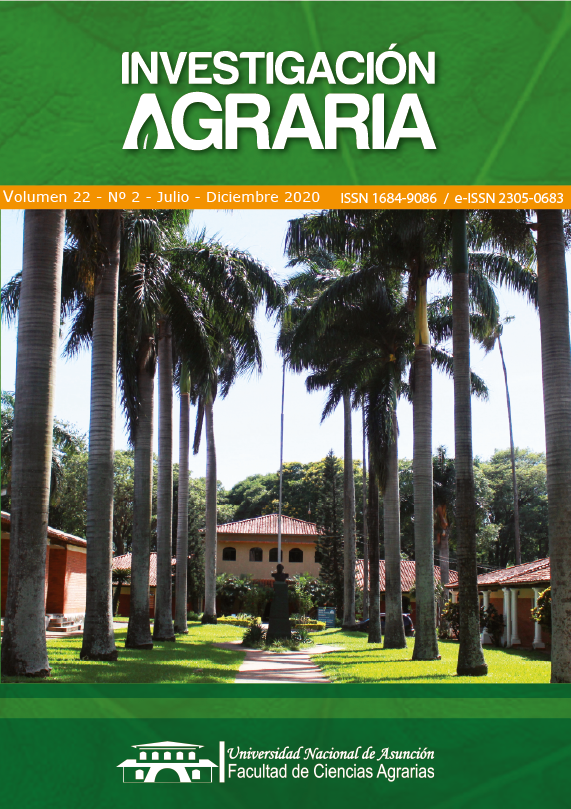Effectivity of ozone on Sitophilus oryzae (L.) (Coleoptera: Curculionidae) under laboratory condition
DOI:
https://doi.org/10.18004/investig.agrar.2020.diciembre.2202640%20Keywords:
insecticide, silo, Sitophilus oryzaeAbstract
Ozone has been used as a control strategy to fungi and insects which affect grains and stored foods, due to be highly reactive and its strong oxidizing activity. In this research the insecticide effect of ozone at concentration of 20 ppm, was evaluated on adults of rice weevil, Sitophilus oryzae (L.), applied during 15, 30, 45 and 60 minutes, in prototypes of empty silos and silos with maize. The experiment design was completely randomized with factorial array. There were significant differences (P < 0.001) in the mortality percentage of rice weevilin empty silos (53.5%) and those with maize (16.88%). The exposure time also caused a significant effect on the mortality (P < 0.001), which increased as time did and reached the highest value at 60 minutes (58.25%). Similarly, the interaction silo condition by exposure time to ozone was significative (P < 0,001) and allowed to see differences in the mortality of S. oryzae, which percentages were higher in empty silos than in silos with maize. These results show that ozone had a moderate insecticide effect on S. oryzae.Downloads
Metrics
References
Alonso, M., Ávila, J. y Calcagno, M. (2009). Los cereales en el trópico suramericano: Técnicas modernas de conservación. CDCHT ULA, Fundación Empresas Polar. Caracas, Venezuela.
Campabadal, C.A., Maier, D.E. & Mason, L.J. (2013). Efficacy of fixed bed ozonation treatment to control insects in stored bulk grain. Applied Engineering in Agriculture, 29(5), 693-704.
Dos Santos, J.E., Martins, M.A., Faroni, L.R., Pereira de Andrade, M. & Silva, M.C. (2007).Ozonitation process: Saturation time, decomposition kinetics and quality of maize grains (Zea mays L.). En: IOA (International Ozone Association) Conference and Exhibition. Valencia, España.
Faroni, L.R., Pereira, A.M., Sousa, A.H., Coelho da Silva, M.T. & Irrazabal, W. (2007). Influence of corn grain mass temperature on ozone toxicity to Sitophilus zeamais (Coleoptera: Curculionidae) and quality of oil extracted from ozonized grains. IOA Conference and Exhibition Valencia, Spain. October (29-31). 5.8: 1-6.
Hansen, L.S., Hansen, P. & Jensen, K.M.V. (2012). Lethal doses of ozone for control of all stages of internal and external feeders in stored products. Pest Management Science, 68, 1311-1316.
Hardin, J.A., Jones, C.L., Bonjour, E.L., Noyes, R.T., Beeby, R.L., Eltiste, D.A. & Decker, S. (2010). Ozone fumigation of stored grain: closed-loop recirculation and the rate of ozone consumption. Journal of Stored Products Research, 46, 149-154.
Hasan, M., Phillips, T.W. & Aikins, M.J. (2012). Potential for ozone fumigation against anobiid beetles infesting stored products as an alternative to methyl bromide. En Navarro, S., Banks, H.J., Jayas, D.S., Bell, C.H., Noyes, R.T., Ferizli, A.G., Emekci, M., Işikber, A.A. & Alagusundaram, K. (Eds.) Proc. 9th. Int. Conf. on Controlled Atmosphere and Fumigation in Stored Products, Antalya, Turkey. 15 - 19. October 2012, ARBER Professional Congress Service, Turkey 260 - 265.
Işikber, A.A. & Öztekin, S. (2009). Comparison of susceptibility of two stored-product insects, Ephestia kuehniella Zeller and Tribolium confusum du Val to gaseous ozone. Journal of Stored Products Research, 45, 159-164.
Işikber, A.A. & Athanassiou, C.G. (2015). The use of ozone gas for the control of insects and micro-organisms in stored products. Journal of Stored Products Research, 64, 139-145.
Jian, F., Jayas, D.S. & White, N.D.G. (2013). Can ozone be a new control strategy for pests of stored grain. Agricultural Research, 2(1), 1-8.
Keivanloo, E., Namaghi, H.S. & Haddad, M.H. (2014). Effects of low ozone concentrations and short exposure times on the mortality of immature stages of the Indian meal moth, Plodia interpunctella (Lepidoptera: Pyralidae). Journal of Plant Protection Research, 54(3), 267-271.
Kells, S.A., Mason, L.J., Maier, D.E. & Woloshuk, C.P. (2001). Efficacy and fumigation characteristics of ozone in stored maize. Journal of Stored Products, 37(4), 371-382.
Mason, L.J., Woloshuk, C.P. & Maier, D.E. (1997). Efficacy of ozone to control insects, moulds and mycotoxins. En: Donahaye, E.J., Navarro, S., Varnava, A. (Eds.). Proceedings of the International Conference on Controlled Atmosphere and Fumigation in Stored Products. Nicosia. 665-670 pp.
Pandiselvam, R., Sunoj, S., Manikantan, M.R., Kothakota, A. & Hebbar, K.B. (2016). Application and kinetics of ozone in food preservation. Ozone: Science & Engineering. https://doi.org/10.1080/01919512.2016.1268947
Pereira, A.D.M., Faroni, L.R.D., Sousa, A.H., Urruchi, W.I. & Paes, J.L. (2008). Influence of the grain temperature on the ozone toxicity to Tribolium castaneum. Revista Brasileira de Engenharia Agrícola e Ambiental, 12, 493-497.
Reza, G., Asgar, A. & Hasan, M. (2011). Combined effect of ozone mixed with carbon dioxide on the mortality of five stored-product insects. Egyptian Academic Journal of Biological Sciences, 4(2), 9-19.
Rozado, A.F., Faroni, L.R.A., Urruchi, W.M.I., Guedes, R.N.C. & Paes, J.L. (2008). Aplicação de ozônio contra Sitophilus zeamais e Tribolium castaneum em milho armazenado. Revista Brasileira de Engenharia Agrícola e Ambiental, 12(3), 282-285.
Solano, Y., Triana, J., Ávila, R., Hernández, D. y Morales, J. (2017). Efecto del ozono sobre adultos del gorgojo del cigarrillo, Lasioderma serricorne (F.) (Coleoptera: Anobiidae). IDESIA (Chile), 35(2), 41-47 http://dx.doi.org/10.4067/S0718-34292017005000007
Sousa, A.H., Faroni, L.R.A., Pimentel, M.A.G., Silva, G.N. & Guedes, R.N.C. (2016). Ozone toxicity to Sitophilus zeamais (Coleoptera: Curculionidae) populations under selections pressure from ozone. Journal of Stored Products Research, 65, 1-5.
Sousa, A.H., Faroni, L.R.A. & Guedes, R.N.C. (2017). Locomotor behavior of Sitophilus zeamais populations under sublethal ozone exposure. Journal of Pest Science, 90, 239-247.
Trombete, F.M., Freitas-Silva, O., Saldanha, T., Venáncio, A.A. & Fraga, M.E. (2016). Ozone against mycotoxins and pesticide residues in food: Current applications and perspectives. International Food Research Journal, 23(6), 2545-2556.
Wysok, B., Uradzinski, J. & Gomólka-Pawlicka, M. (2006). Ozone as an alternative disinfectant - A review. Polish Journal of Food and Nutrition Sciences, 15/56(1), 3-8.
Published
How to Cite
Issue
Section
License

This work is licensed under a Creative Commons Attribution 4.0 International License.
All content in this journal is under Creative Commons Attribution License.









 All content in this journal is under
All content in this journal is under 